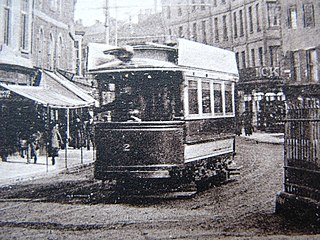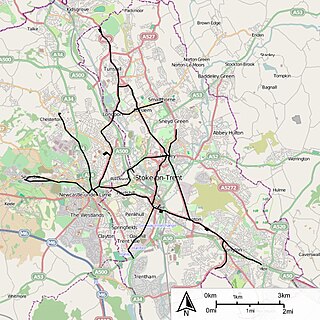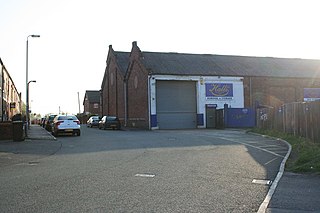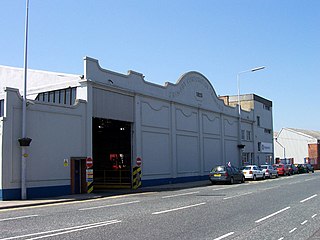Brush Traction was a manufacturer and maintainer of railway locomotives in Loughborough, England whose operations have now been merged into the Wabtec company's Doncaster UK operations.

Widley is an area of the Greater Portsmouth conurbation in Hampshire, near Waterlooville and Purbrook. It is on the dip slope of the South Downs just north of the ridge called Portsdown Hill.
Trams in India were established in the late 19th century. Horse-drawn trams were introduced in Kolkata in 1873; in Mumbai, trams began operations in 1874; in Nashik in 1889; electric trams began in Chennai in 1895, and trams were also introduced in Kanpur and Delhi. They were discontinued in all Indian cities between 1933 and 1964, except for Kolkata.

Cosham is a northern suburb of Portsmouth lying within the city boundary but off Portsea Island, in the ceremonial county of Hampshire, England. It is mentioned in the Domesday Book of 1086 along with Drayton and Wymering (mainland) and Bocheland (Buckland), Frodington (Fratton) and Copenore (Copnor) on the island.

Between 1901 and 1949 Manchester Corporation Tramways was the municipal operator of electric tram services in Manchester, England. At its peak in 1928, the organisation carried 328 million passengers on 953 trams, via 46 routes, along 292 miles (470 km) of track.

Portsmouth Corporation Transport was a tram, trolleybus and bus operator formed in 1898, serving the city of Portsmouth, and owned by Portsmouth Corporation. Tram services ended in 1936, trolleybus services in 1963, while bus operations continued until the company was privatised in 1988.

The Taunton Tramway was an electric street tramway in Taunton, the county town of Somerset, England. It operated a fleet of six narrow gauge tramcars on a single route of 1.66 miles (2.67 km) between 1901 and 1921 when the tramway closed due to a dispute over the cost of electricity.

Wrexham and District Electric Tramways was a company that operated an electric tramway service in Wrexham, Wales between 1903 and 1914 when it was renamed Wrexham and District Transport Company Limited. Trams continued to operate until 1927.

Nelson Corporation Tramways operated a tramway service in Nelson, Lancashire between 1903 and 1934.
The Worcester Electric Traction Company operated a tramway service in Worcester between 1904 and 1928.

Coventry Corporation Tramways operated a tramway service in Coventry, England, between 1912 and 1940.

The Potteries Electric Traction Company operated a tramway service in The Potteries between 1899 and 1928.

Walsall Corporation Tramways operated a tramway service in Walsall between 1904 and 1930.

Wigan Corporation Tramways operated a tramway service in Wigan, England, between 1901 and 1931. The first tramway service in the town was run by the Wigan Tramways Company, whose horse trams began carrying passengers in 1880. They began replacing horses with steam tram locomotives from 1882, but the company failed in 1890 when a Receiver was appointed to manage it. The Wigan & District Tramways Company took over the system in 1893 and ran it until 1902. Meanwhile, Wigan Corporation were planning their own tramway system, obtaining an authorising Act of Parliament in 1893, and a second one in 1898. This enabled them to build electric tramways, and in 1902, they took over the lines of the Wigan & District Tramways Company.
At the peak of Britain’s first-generation tramways, it was possible to travel by tram all the way from Pier Head at Liverpool to the Pennines in Rochdale by tram.
Rhondda Tramways Company operated a tramway service in Rhondda, Wales, between 1904 and 1934.
Llanelly and District Electric Tramways operated a standard gauge tramway service in Llanelli, Wales, between 1908 and 1933. It was the successor to a 3 ft gauge horse tramway, which ran from 1882 until 1908. A complex series of negotiations took place in the early 1900s, resulting in the horse tramway being converted to an electric tramway. Standard gauge horse trams were run initially, until the company completed North Dock power station, which supplied electricity to the tramway. Two of the employees who worked on the construction went on to found Balfour Beatty.
Halifax Corporation Tramways operated a tramway service in Halifax, West Yorkshire, England between 1898 and 1939. After considering lifts and inclined planes to assist trams in negotiating the steep hills to the south of the town, they obtained permission to build a conventional system in 1897, and the first three routes opened in 1898. By 1905 there were 37 miles (60 km) of track and 96 tramcars, supplied by two manufacturers. In 1921, an additional route was added to the system, and the Corporation embarked on a programme of building their own tramcars, some of which replaced existing vehicles, while some extended the fleet. During the 1930s, the trams were gradually replaced by motor buses, either run by the Corporation or by private companies, and the last tram ran on 14 February 1939.
The Provincial Tramways Company was a holding company for horse tramway companies in various regional towns of England. It was floated in July 1872 by means of a prospectus inviting public subscription for shares in the new company. The published prospectus lists the towns where it was proposed to operate horse tramways as Plymouth. Cardiff, Dundee. Portsmouth. Southampton and Tynemouth. Initially those in Plymouth and Cardiff were constructed and in operation as reported to the half yearly meeting of the company in 1873.
The Portsmouth Street Tramways Company operated horse tramways in Portsmouth, England. It was started under the terms of a Provisional Order of 1874 and was a wholly owned subsidiary company of The Provincial Tramways Company.

The Great Grimsby Street Tramways Company was a tramway serving Grimsby and Cleethorpes in Lincolnshire, England. It was a subsidiary of The Provincial Tramways Company. They opened a horse tramway in 1881, running from the Wheatsheaf Inn in Bargate to the border with Cleethorpes, with a branch along Freeman Street, and extended the line into Cleethorpes in 1887. It followed the trend of many British systems, and was converted to an electric tramway in December 1901. Small extensions were made to the system at both ends, but the basic plan of the system remained the same throughout its life.













